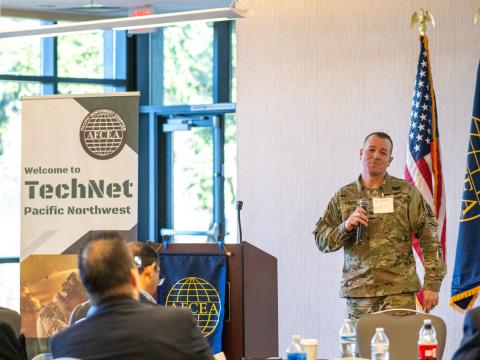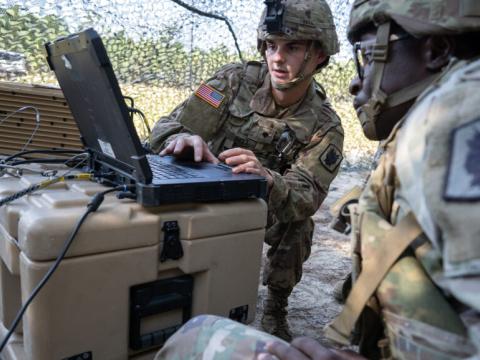Technology Renovation Program Transforms Military Headquarters
Top to bottom overhaul replaces hodgepodge of systems with state-of-the-art, coordinated technology plan
Unity and simplicity are moving to the Pentagon. After more than 50 years of accumulating individual communications technologies to meet information distribution needs, the military headquarters is following the lead of its individual services and is well on its way, on time and on budget, to creating a joint and integrated information technology system.
The renovation effort, while incorporating today’s most current technologies, is also leaving avenues open for technologies yet to be developed. The design, which initially features separate systems for voice, data and video, will ultimately be collapsed into a single backbone. New network administration technologies will reduce the time required to monitor and repair systems.
But plans call for more than just capabilities to be combined. When the transformation is complete, the current individual U.S. Army, Navy, Air Force and Marine Corps systems will operate as a joint system, and advances in technology could bring the existing four security backbones into a single environment with separation taking place at the faceplate instead of the backbone.
Mindful of the rapid pace of technology change as well as personal preferences, planners view flexibility as crucial to systems being designed to fulfill the needs of Pentagon residents well into the next century. Asynchronous transfer mode (ATM) is at the core of the architecture, but edge devices will allow users to employ their own preferences including token ring, fiber distributed data interface, transmission control protocol/Internet protocol or even ATM.
Multiple local area networks (LANs), both classified and unclassified, will be replaced by a single backbone for each security level. The current 22 red secure and black general-purpose switches will be reduced to eight. Two cable television systems will be combined into a single system. The 11 general-purpose and three command and control automated data processing centers will be consolidated into two general-purpose centers and one command and control center. Work now conducted in two radio rooms will be managed in one room, and a consolidated message support center will replace three message centers now in place. Command and operations centers will be collocated in the Pentagon basement. Videoconferencing capabilities will be designed and implemented on one set of standards so they are uniform throughout the building for both desktop and large conferencing functions.
The Army’s information management and telecommunications (IM&T) project management office is spearheading the effort. GTE Government Systems, Arlington, Virginia, is the primary contractor for the renovation on the above-ground telecommunications backbone. The firm leads a team of 11 subcontractors and two electronic equipment suppliers, under a contract valued at approximately $110 million for work to be conducted during the next 10 years.
Col. Robert A. Kirsch II, USA, IM&T project manager, says that, while the team is exploring emergent technologies, at this point only well-established techniques are being incorporated into the plan.
“The only experimentation we are willing to do is outside of the implementation of the renovation. We’re doing a lot of that. We are looking at technology that is coming down the pipe. But we’re interested in doing state-of-the-art [technology] that we know is mature enough to provide the user capabilities that are required, but it is not so state-of-the-art that there are potential pitfalls that we might encounter because it hadn’t been fully tested,” Col. Kirsch notes.
“As time goes by, we have the ability to upgrade the active components. The passive infrastructure we’re installing is being implemented in such a way that allows us to implement for the next 50 years, because we use both multimode and single-mode fiber as the sole path for the backbone and twisted pairs going out from the edge device to the users for telecommunications,” he adds.
Although the information technology renovation is a current focus, the monumental task of updating the Pentagon’s top five floors actually began several years ago. The project was divided into five wedges. Temporary quarters have been set up in three buildings in nearby Rosslyn and Crystal City and in nonrenovation areas of the Pentagon to act as swing space. Each location is equipped with information technology systems that allow personnel from the section undergoing renovations to continue to communicate with workers not affected by the construction.
Consolidation of the numerous systems that have arisen over the years is at the center of the work. Much of the existing twisted pair wire, fiber optic and coaxial cables are unstructured and unmapped, with only the individual agencies being aware of the layout of their own wires. Col. Kirsch estimates that as much as 50 percent are not being used, and many times active wiring is not identified until repairs are required. After the renovation is complete, this will no longer be the case, he adds.
Administration of the systems is also being consolidated. Information technology management now conducted in seven technical control facilities will be accomplished in one primary location, and multiple network management centers will be replaced with a single center. In addition, to address the problem of accumulated wiring systems that have been installed for additional capabilities in the last several decades, a highly structured implementation system has been put in place. The Pentagon’s physical construction of poured concrete has so far been an advantage in this part of the effort. The structure can be gutted down to the concrete, whereby new conduit and cable trays will be installed. Contractors will place new fiber and twisted pair cables as required. The well-documented installation will enable future capabilities to be added either by employing existing infrastructure that is not in use or by putting new wiring in place as needed, the colonel explains.
Initial plans call for four physically separate networks, one for each security level of unclassified, secret, top secret and sensitive compartmented information. Each backbone is designed using a synchronous optical network, or SONET, ring, ATM switches and frame switches. The equipment will be centrally located in communications equipment rooms and telecommunications closets.
ATM technology was chosen because the renovation team believes it will enable additional capabilities as technologies evolve. “The objective is to integrate voice, data and video onto a single backbone as technology becomes available,” Sajeel Ahmed, IM&T senior systems engineer, explains. “On the user side, this could mean telephones integrated with computers—one device instead of two—and desktop video from the same network, running through one pipe. The technology is not there just yet, but that’s what we’re shooting for.” Some of these technologies are still being developed in laboratories; they are not economical to install at this time or the quality of service is currently not at the level required, he adds.
Dependability and life-cycle costs were also substantial considerations in designing the new systems. They are two of the reasons commercial off-the-shelf technologies are being used. “We want to put something in that is mature,” Robert W. Morris, IM&T product manager for information technology systems, explains. “We want the U.S. commercial world to be using this before we go to it.
“When we designed the backbone, we looked at concerns and design considerations, laid it out over the life cycle, and tried to figure out which ones were most important and had the most lasting effects. We determined that the most important consideration was adequate, powered, conditioned space. The next thing was the pathways to connect those spaces, then the media itself in terms of what kinds of fiber. The next piece was the hardware, the switches themselves, then finally the software that rides those switches. Each one has a shorter and shorter life cycle. Technology changes every 18 months. We can just change the switch or modify software,” Morris relates.
The nature of Pentagon operations influenced these choices. “In the building, users move around a lot, or new groups form quickly for crises,” Ahmed explains. “We had to implement something so that we can reconfigure the backbone or a piece of the backbone quickly so it is all part of the infrastructure instead of running more cables. Instead of building four separate infrastructures, we have one physical infrastructure, but we are using virtual LAN technology to keep traffic separate between organizations. This also allows us to reconfigure the network quickly as requirements change.”
“From the data backbone perspective, it is the ultimate purple system,” Col. Kirsch adds. “Security is a concern. Current technology does not allow us to collapse all levels of classification into a single backbone. We are headed in that direction and the ability will be there in the future using things like fast-lane technology, which provides ATM encryption.” Under current design plans, equipment from each security level shares physical space with a separate fiber path for each of them down to the faceplate. If technology advances occur during the renovation period that would allow a single backbone to be used for all security levels, it would be incorporated into the system; however, separation would still be necessary at the faceplate level, the colonel says.
Continued interoperability between currently available and future technology has been key in the overall design of the renovation program. GTE’s contract includes wedge-one work with options for wedges two through five. The company has been given total latitude in providing the solutions for requirements that the IM&T team has identified as part of the architecture. “In wedge two, when [GTE] resubmits its architecture and wedge design, if it chooses to go to different subcontractors for hardware, it would be responsible for demonstrating interoperability and integration between those devices,” Morris says. “If new technology comes up in the next 10 years, we will look at that,” Col. Kirsch adds. “If it causes us to change the architecture, we would change and GTE would implement active components that would allow us to move to that technology.”
The company is required to update and resubmit infrastructure and design plans every two years, taking into account any changes in technology, reviewing systems already installed, and forecasting future advances.
“From the user’s perspective, there won’t be anything unique that you can’t or won’t be able to do then. The renovation is not designed to provide a Cadillac for a solid Ford. We are providing state-of-the-art capability that is well structured, well defined, well architected and well implemented,” the colonel maintains.
“If the user has three data drops and a telephone now, that’s what he or she will get. This individual won’t get more. We’re not providing additional capability; we’re meeting users’ current requirements. But we are building infrastructure for the next 50 years, so if a user’s requirements go from three to five, we will be able to provide additional drops,” he adds. To ensure room for growth, 50 percent spare capacity was included in the initial assessment. The renovation program team also conducts industry forums to receive expert input about architecture.




Comments